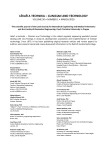MATERIALS SUITABLE TO SIMULATE SNOW DURING BREATHING EXPERIMENTS FOR AVALANCHE SURVIVAL RESEARCH
Autoři:
Karel Roubík 1; Simon Walzel 1; Lenka Horáková 1; Alicia Refalo 2; Karel Sykora 3,4; Vaclav Ort 1; Ladislav Sieger 5
Působiště autorů:
Department of Biomedical Technology, Faculty of Biomedical Engineering, Czech Technical University in Prague, Kladno, Czech Republic
1; École polytechnique universitaire de l'université Lyon-I, France
2; Department of Physiology and Biochemistry, Faculty of Physical Education and Sport, Charles University, Prague, Czech Republic
3; Military Department, Faculty of Physical Education and Sport, Charles University, Prague, Czech Republic
4; Department of Physics, Faculty of Electrical Engineering, Czech Technical University in Prague, Prague, Czech Republic
5
Vyšlo v časopise:
Lékař a technika - Clinician and Technology No. 1, 2020, 50, 32-39
Kategorie:
Original research
doi:
https://doi.org/10.14311/CTJ.2020.1.05
Souhrn
Terrain experiments for avalanche survival research require appropriate snow conditions, which may not be available year round. To prepare these experiments and test the protocol, it might be advantageous to test them in a laboratory with a snow model. The aim of the study was to find a material that can be used to simulate snow for studying gas exchange of a person covered with avalanche snow. Three loose porous materials (perlite, wood shavings and polystyrene) were tested in two forms—dry and moisturized. Each volunteer underwent six phases of the experiment in random order (three materials, each dry and moisturized) during experimental breathing into the tested materials. Physiological parameters and fractions of oxygen and carbon dioxide in the airways were recorded continuously. All the materials selected as possible models of the avalanche snow negatively affected gas exchange during the breathing of the volunteers in a very similar extent. The time courses of the recorded parameters were very similar and were bordered from one side by the wet perlite and from the other side by the dry perlite. Therefore, other tested materials may be substituted with perlite with an appropriate water content. From all the tested materials, perlite is the best to simulate avalanche snow because of its homogeneity, reproducibility and easy manipulation.
Klíčová slova:
avalanche snow – model – snow burial – survival – hypercapnia – breathing experiment
Zdroje
- Page CH, Atkins D, Shockley L, Yaron M. Avalanche deaths in the United States: a 45-year analysis. Wilderness and Environ-mental Medicine. 1999;10:146–51.
- DOI: 10.1580/1080-6032(1999)010[0146:aditus]2.3.co;2
- Jekich BM, Drake BD, Nacht JY, Nichols A, Ginde AA, Davis CB. Avalanche fatalities in the United States: a change in demo-graphics. Wilderness & environmental medicine. 2016 Mar 1; 27(1):46–52. DOI: 10.1016/j.wem.2015.11.004
- Boyd J, Haegeli P, Abu-Laban RB, Butt JC. Patterns of death among avalanche fatalities: a 21-year review. Canadian Medical Association Journal. 2009;180(5):507–12. DOI:10.1503/cmaj.081327
- McIntosh SE, Grisom CK, Olivares CR, Tremper B. Cause of death in avalanche fatalities. Wilderness & Enviromental Medicine. 2007;18(4):293–7.
- DOI: 10.1580/07-WEME-OR-092R1.1
- Hohlrieder M, Brugger H, Schubert HM, Mair P. Pattern and severity of injury in avalanche victims. High Altitude Medicine & Biology. 2007;8(1):56–61. DOI: 10.1089/ham.2006.0815
- Falk M, Brugger H, Adler-Kastner L. Avalanche survival chances. Nature. 1994;368:21. DOI: 10.1038/368021a0
- Grissom CK, Radwin MI, Harmston CH, Hirshberg EL, Crowley TJ. Respiration during snow burial using an artificial air pocket. Jama. 2000;283(17):2261–71. DOI: 10.1001/jama.283.17.2266
- Paal P, Strapazzon G, Braun P, Ellmauer PP, Schroeder DC, Suman G, et al. Factors affecting survival from avalanche burial–A randomised prospective porcine pilot study. Resuscitation. 2013;84(2):239–43. DOI: 10.1016/j.resuscitation.2012.06.019
- Brugger H, Sumann G, Meister R, Adler-Kastner L, Mair P, Gunga HC. Hypoxia and hypercapnia during respiration into an artificial air pocket in the snow: implications for avalanche survival. Rescuscitation. 2003;58:81–8.
- DOI: 10.1016/s0300-9572(03)00113-8
- Strapazzon G, Paal P, Schweizer J, Falk M, Reuter B, Schenk K, Gatterer H, Grasegger K, Dal Cappello T, Malacrida S, Riess L. Effects of snow properties on humans breathing into an artificial air pocket–an experimental field study. Scientific reports. 2017; 7(1):17675. DOI: 10.1038/s41598-017-17960-4
- Radwin IM, Grisom CK, Scholand MB, Harmston CH. Normal Oxygenetation and Ventilation during Snow Burial by the Exclusion of Exhaled Carbon Dioxine. Wilderness Environ-mental & Medicine. 2001;12:256–62.
- DOI: 10.1580/1080-6032(2001)012[0256:noavds]2.0.co;2
- Ahn J, Headly M, Wahlen M, Brook EJ, Mayewski PA, Taylor KC. CO2 diffusion in polar ice: observations from naturally formed CO2 spikes in the Siple Dome (Antarctica) ice core. Journal of Glaciology [online]. 2008;54(187):685–95.
- DOI: 10.3189/002214308786570764
- Hemmingsen E. Permeation of Gases through Ice. Institute of Zoophysiology, University of Oslo (1958). Tellus 11, 355–9. DOI: 10.1111/j.2153-3490.1959.tb00041.x
- American Society of Anesthesiologists, INC. New Classifi-cation of Physical Status, Anesthesiology, 1963; 24: 111.
- Roubík K, Sieger L, Sykora K. Work of Breathing into Snow in the Presence versus Absence of an Artificial Air Pocket Affects Hypoxia and Hypercapnia of a Victim Covered with Avalanche Snow: A Randomized Double Blind Crossover Study. PLoS ONE. 2015;10(12):e0144332.
- DOI: 10.1371/journal.pone.0144332
- Lumb AB. Nunn's Applied Respiratory Physiology. 7th edition. Elsevier, 2012.
Štítky
BiomedicínaČlánek vyšel v časopise
Lékař a technika

2020 Číslo 1
Nejčtenější v tomto čísle
- VERIFICATION OF CLINICAL ACCURACY OF AUTOMATED NON-INVASIVE SPHYGMOMANOMETERS: IS IT APPROPRIATE TO USE BLOOD PRESSURE SIMULATORS?
- INFLUENCE OF THE USE OF GRAVITY SETS IN A PRESSURE VOLUMETRIC INFUSION PUMP WITH AN IMPACT ON THE ACCURACY OF INFUSION SOLUTION FLOWS
- FUNCTIONALIZATION OF POLYMERIC NANOFIBERS USING PLATELETS FOR MELANOCYTE CULTURE
- FREQUENCY AND DURATION OF OXIMETER DROP-OUTS IN THE NICU: AN OBSERVATIONAL STUDY
